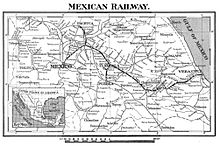- Mexican Railway
-
The Mexican Railway (Ferrocarril Mexicano) (reporting mark FCM) was one of the primary pre-nationalization railways of Mexico. Incorporated in London in September 1864 as the Imperial Mexican Railway (Ferrocarril Imperial Mexicano) to complete an earlier project, it was renamed in July 1867[1] after the Second French Empire withdrew from Mexico. The main line from Mexico City to Veracruz was dedicated on January 1, 1873 by President Sebastián Lerdo de Tejada; branches connected Ometusco to Pachuca and Apizaco to Puebla.[2][3]
The Mexican Railway remained independent of the government-owned Ferrocarriles Nacionales de México (National Railways of Mexico) until the government gained control in June 1946 and merged the property in March 1959.[4] Following privatization in the 1990s, Ferrosur acquired the lines of the former Mexican Railway.
References
- ^ Pan-American Magazine and New World Review, 1923, p. 28
- ^ Fred Wilbur Powell, The Railroads of Mexico, Stratford Company (Boston), 1921, pp. 102-103
- ^ Manual of Statistics Company (New York), The Manual of Statistics: Stock Exchange Hand-Book, 1908, pp. 195-196
- ^ Tothill Press, Directory of Railway Officials & Year Book, 1961-1962, p. 272
Categories:- Defunct railway companies of Mexico
- History of Mexico
- Railway companies established in 1867
- Railway companies disestablished in 1959
Wikimedia Foundation. 2010.

